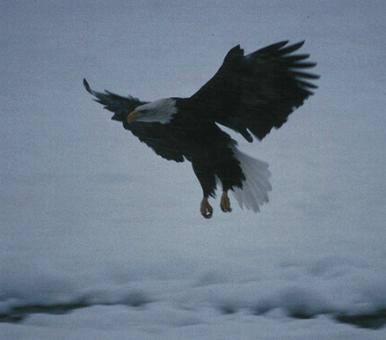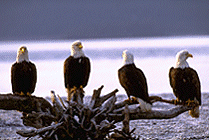
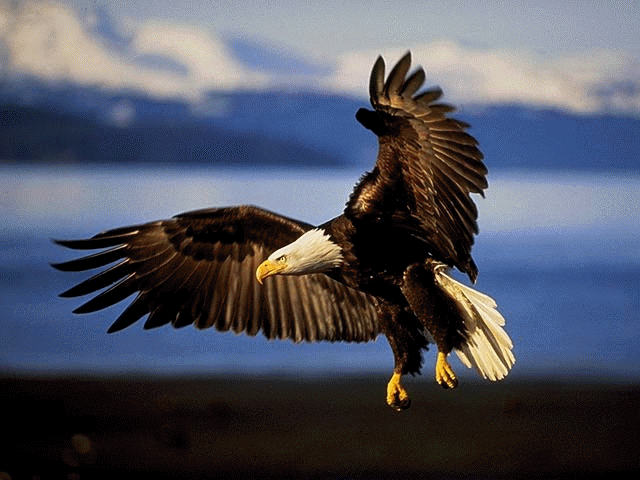


The Bald Eagle

Eagle Facts
EGGS
A bald eagle egg is slightly smaller than a domestic goose egg. The chick will measure 4 to 5 inches at hatching and weigh only a matter of ounces.
Bald eagles incubate their eggs for about 35 days. They begin incubation as soon as the first egg is laid. The second egg usually appears within 36 to 72 hours after the first. Occasionally a clutch of 3 eggs will be produced.
CHICKS
The eagle chick will be fed a steady diet of fish, occasionally supplemented by waterfowl (ducks, geese) or waterbirds (gulls, cormorants). About 85% of the chicks diet will consist of fish. Fish like carp, white sucker, shad, bullhead and sunfish are most frequently caught. The adults will tear the fish into small strips and offer it to the chick. The chick will snatch it from the adult's beak and swallow it. The chick will eat as much as it can at a feeding, storing food in its crop. The crop will appear distended (enlarged) as it fills, resembling a golf ball at the base of the neck.
HUNTING & FEEDING
The male does most of the hunting and scavenging during the early weeks of the chick's life. The female does the majority of the feeding and brooding. The male will often eat the head of the fish he catches and then bring the remainder to the nest. The male will brood and feed the chick when the female is off the nest. She will leave to stretch, defecate, bathe, preen and hunt on her own.
THE ADULTS
The male eagle is smaller than the female. He weighs about 10 lbs. and the female tips the scales at about 14 lbs. Being smaller, he is slightly quicker and more agile, giving him an advantage in catching prey. She, being larger, is better able to incubate the eggs and brood the young chick, using her body to shelter her offspring from cold, soaking rains or hot sun. The male's wingspan is a little more than 6 feet from wingtip to wingtip, the female's is between 6.5 and 7 feet.
BAND THE BIRD
Both adults are leg banded. The female has a single silver band and was released as part of the Massachusetts Bald Eagle Restoration Project at Quabbin Reservoir in 1985. The male has a silver band on one leg and a blue band on the other. He was likely banded as a chick in a wild nest in New York state sometime around 1990. He replaced the original male, a bird released at Quabbin in 1986, when the original bird failed to return to the territory in 1995.
CHICK'S GROWTH
The chicks will be nearly full grown at 9 weeks of age. They will add some weight as they develop their flight muscles after they leave the nest. Their wingspan will be as large or slightly larger than the adults at this time.
FIRST FLIGHT
First flights usually occur at 9 or 10 weeks of age. They are proceeded by vigorous exercising and flapping. The chick will typically lift off of the nest by facing into the prevailing winds and flapping. Often its first flight will be only to the nearest branch above the nest. When they leave the nest they usually glide to a nearby tree or stump. They will return to the nest tree frequently and continue to be fed by the adults.
CHICKS LEAVING THE NEST
As the chicks develop their flight skills they harass the adults and try to take fish from them. This behavior will last into September. As of October, the bond between the adults and their young will fade and the adults will no longer tolerate the harassment from their offspring. This is time when the young eagles leave the territory, usually heading north in the early fall to find good fishing grounds.
EAGLES & MIGRATION
Eagles don't migrate in the sense that robins and bluebirds do. Eagles only travel as far as they have to in order to find food. This is particularly true of adult eagles with established territories. Adults will stay on their territory (roughly 1 - 6 square miles) tyear round, as long as there is open water nearby when they can hunt fish and waterfowl. Should a severe winter limit the food supply, eagles will move as far south as necessary to find open water and suitable hunting grounds.
YOUTH TO ADULT
The young eagle will spend the next 4 years of its life wandering across eastern North America looking for summering and wintering areas where food is accessible. The mortality rate for eagles during their first year of life is greater than 50%, but once they have learned to hunt and forage successfully their chances of reaching adulthood are good. When they begin to mature at age 4, the eagle will seek a mate and establish a territory. The territory is usually located within 250 miles of the nest where the eagle was hatched.
There, the new pair of eagles will construct their own nest but often don't produce eggs or young during their first year as a pair. They'll return in following years to raise young of their own.
DISTANCE TRAVELED
Immature eagles wander great distances in search of food. Birds banded in Massachusetts have been sighted as far away as West Virginia and southern Canada. Eagles sighted in Massachusetts have come from as far away as Maine, New York, New Jersey, Pennsylvania, Connecticut, New Hampshire and Michigan.
The eagle facts were provided by the Massachusetts Division of Fisheries and Wildlife.

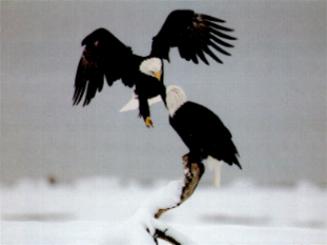



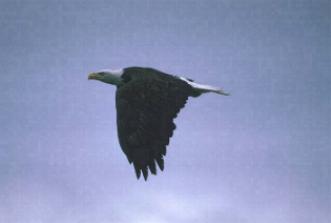


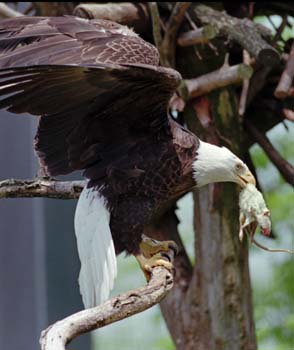






Below Are A Couple Of Links On How We Can All Help To Save The Eagles.
"The National Foundation To Protect America's Eagles"

"The Raptor Center At University Of Minnesota"

Click The Icon For Next Page Of Eagles

HOME
Background By























